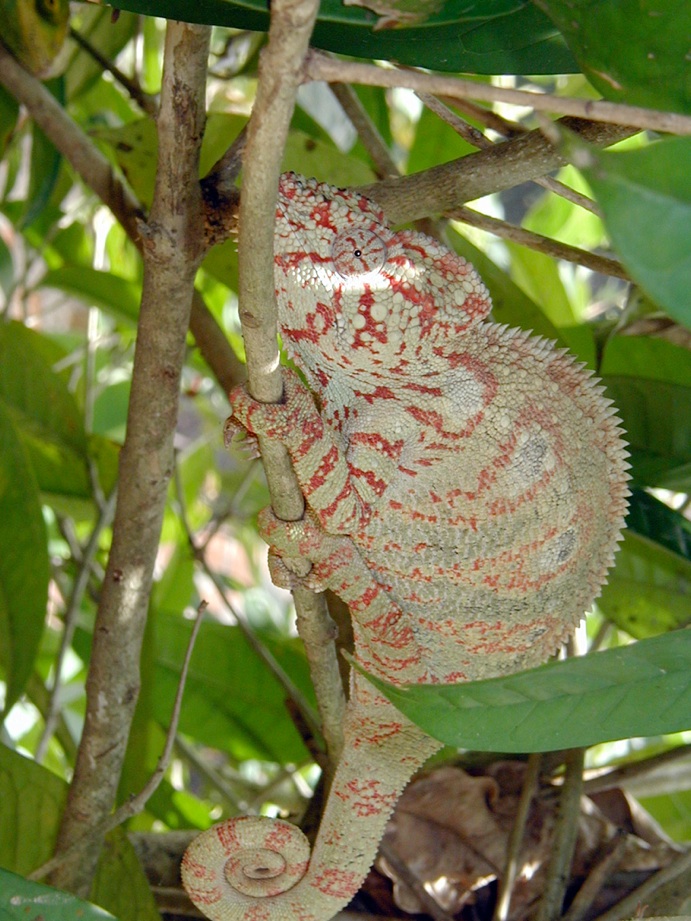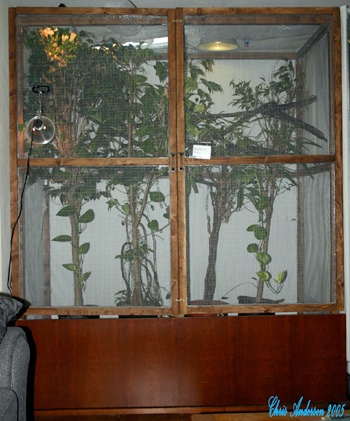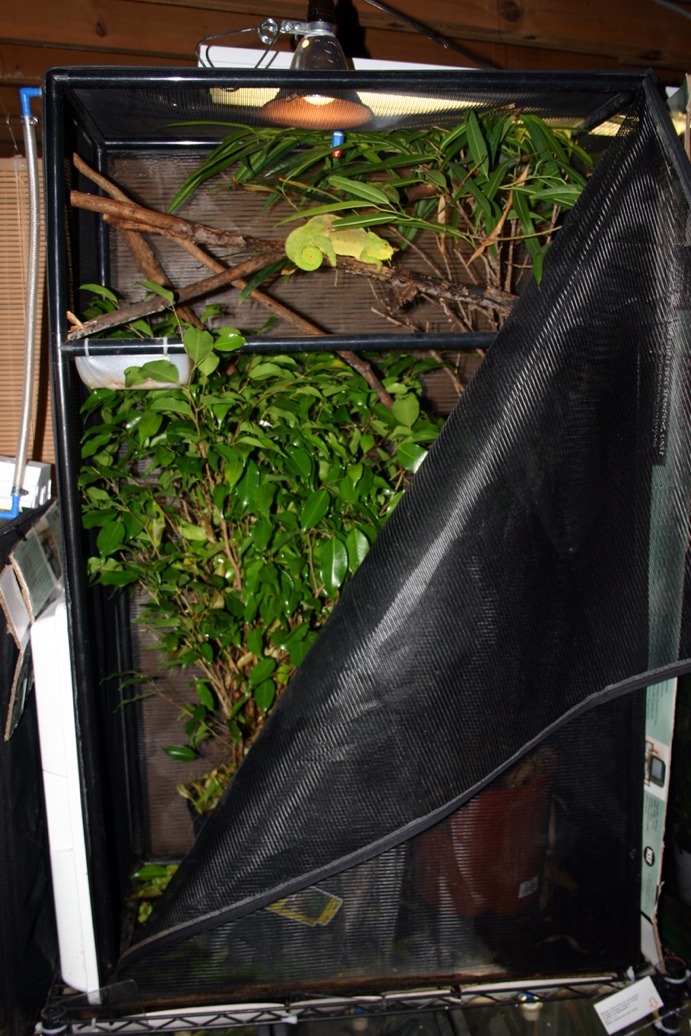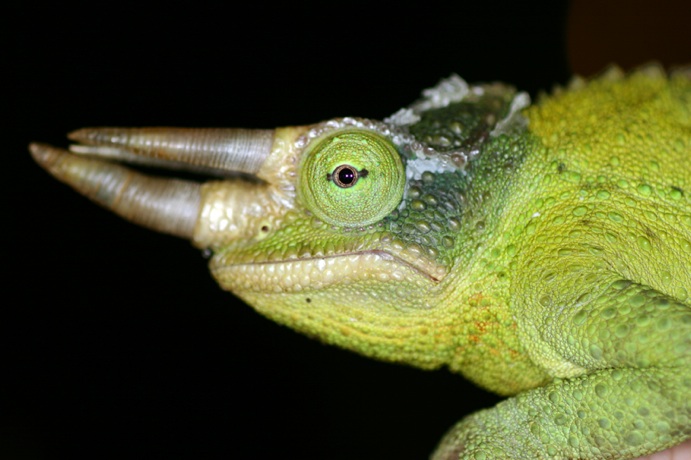



Introduction to Chameleon Husbandry
By Christopher V. Anderson
Citation:
Anderson, C.V. (2005). Introduction to chameleon husbandry. Chameleons! Online E-Zine, December 2005. (http://www.chameleonnews.com/05DecAndersonIntro.html)
The skills involved in chameleon keeping are very different than those necessary for keeping other reptiles. Chameleons have a tendency to be much more delicate than many other animals and are much less forgiving of keeper error. As a result, it is advisable to prepare for your first chameleon well in advance and to follow a few basic principles to help ensure that you have a good experience with chameleons and most importantly, that the animal thrives.
Primary Note on Chameleons: A look at stress
There are a few things about chameleons that you should understand before deciding to keep them. Understanding these fundamentals can delineate between success and failure and may help you understand some of their care requirements. The majority of said requirements stem from chameleon's tendency to stress easily.
Despite the fact that chameleons are beautiful animals and people are drawn to them, they become extremely stressed by exposure to people and other animals. Minimizing this exposure must be a priority. Specifically, these animals should not be purchased with the intention of being handled more often than for the occasional health check. They do best as display animals in a low traffic area of your home where other animals will not be bothering them and children will not be interacting with them unsupervised.
Chameleons are not social animals, they are actually quite solitary. Keeping multiple chameleons, even those of the same sex, in a single enclosure is extremely stressful for them. A cage for multiple chameleons would need to be excessively large and complicated in design to ensure the animals' complete ability to avoid each other. Further, a higher level of experience is required to make sure that any signs of stress are immediately noted and taken care of. For more information on cohabitation, read our Cohabitation article, but keep in mind, under the majority of circumstances it is an extremely dangerous practice for any but the most experienced keeper.
Species Selection
The first step toward a rewarding experience with chameleons is the selection of an appropriate species. New keepers should avoid wild caught (WC) specimens at all costs and seek out captive bred (CB) animals. While WC animals are generally less expensive up front, the costs needed to have them flourish in captivity far exceed the difference in price between WC and CB. Even still, many WC animals will fail to correctly acclimate to captive conditions. If you are unsure about whether an animal is WC or CB, ask the seller specifically but recognize that many sellers, particularly pet shops, do not actually know. In these cases, it is best to be cautious and avoid anything you are not positive about.
It is a safe bet that all veiled chameleons (Chamaeleo calyptratus) will be captive bred, as WC veiled chameleons are highly sought after, very rare, and noticeably more expensive than CB veiled chameleons. Panther chameleons (Furcifer pardalis) are often available as CB but are still imported in large numbers every year so you should be careful to differentiate between the two. Jackson's chameleons (Chamaeleo jacksonii xantholophus) are very commonly collected in Hawaii (where there are feral populations) and sold in the pet trade elsewhere in the United States. Occasionally CB specimens are available, but less often than the other above mentioned species. All other species should be considered WC unless specifically noted to be CB and even then, take caution when believing some of these claims. Most other chameleon species are rarely bred in captivity with any regularity, but are still frequently available as WC specimens.

In general, veiled and panther chameleons are considered to be two of the best species for beginning keepers. Some individuals add Jackson's chameleons to this list, but their care needs have a tendency to be slightly more demanding and are less forgiving than veileds and panthers. When available, and when large enough enclosures are possible, CB Oustalet's chameleons (Furcifer oustaleti) also make very good chameleons for new keepers.
In general, for a first chameleon, you might want to consider a male over a female. Since females will produce eggs even without the presence of a male and because this egg production involves special nutritional requirements, males are far less problematic and generally easier animals with which to learn the ropes. Those interested in getting a female should also read about chameleon reproduction, egg laying, and nutrition (all available in other articles from the Chameleons! Online E-Zine) before proceeding, as even without a male, your chameleon is highly likely to produce infertile clutches of eggs.
Male veiled and panther chameleons both tend to have very impressive display patterns and colorations, which are often major factors for those interested in purchasing a chameleon. Both are larger species which tend to do best as adults in an enclosure of about 48”x 24”x 24” (height x length x width). Male Oustalet's chameleons are significantly larger and will do best in even larger enclosures. While enclosures this size are often something new keepers attempt to avoid, there really is no good substitute to starting with these species and accepting their need for large enclosures. Unwillingness or inability to fully provide these cage requirements is a main reason many find them so difficult to keep and as a result the animals tend to not do well. If you are not able to provide for them as they need, a chameleon may not be for you.
There are draw backs to each of the above mentioned species and obviously, there are benefits to each as well.
Veiled chameleons have a tendency to be less expensive than most other species due mostly to their high proliferation rates in captivity. On the other hand, this species frequently has a poor disposition. You need to recognize that chameleons are not animals to be held frequently and should only be kept as display specimens. This does not pose a problem for most, but some keepers still have difficulty with it. Their coloration, tall casque, impressive displays, and overall hardiness make veileds popular first chameleons.
Panther chameleons are beautiful animals with amazing colors. Their patterns, color changing ability, and the stunning sense of aura that surrounds them make them popular first chameleons as well. Their higher price, however, often turns people away.

Male Ambilobe Panther Chameleon (Furcifer pardalis). Photo courtesy of Chris Anderson
Jackson's chameleons do not tend to have the extensive color changing ability of many species, but possess three horns which often draw people to them. Most would consider their cost mid range, but their care requirements (cooler temperatures, higher humidity, and more frequent misting) are generally harder to fulfill and Jackson's are less forgiving of deviations from their ideal conditions.
Oustalet's chameleons are very large chameleons which lack the impressive coloration of some of the above species. They are, however, very hardy and quite impressive at their full size.

Female Oustalet's Chameleon (Furcifer oustaleti). Photo courtesy of Chris Anderson
When purchasing a new chameleon, it is always best to try to purchase from a breeder. Many breeders now frequently ship their animals nationwide, and it has become a fairly painless and less risky practice than you may think. Breeders' animals tend to be in better condition than most sold at pet stores or even from some vendors at reptile shows. Purchasing directly from a breeder also gives you the benefit of being able to talk to the breeder and get answers to any future questions. When purchasing a chameleon, be careful not to purchase an animal less than 3 months of age. Reputable breeders would not think of selling a younger animal, and one who does should be avoided. In this issue and previous issues, articles on choosing a dealer and ethics in breeding are all available to help you screen those you are considering purchasing from.
Caging
The need for screen enclosures for your animals is one of the many oddities of chameleon husbandry. While keeping chameleons in glass enclosures is possible, the majority of available glass enclosures are simply not adequate for chameleons because of, among other things, their size and airflow. Glass tanks add a significant amount of complications to keeping chameleons that new keepers should avoid at all costs. While many new keepers do not understand how to maintain humidity and temperature in a wire mesh enclosure throughout the year, it is far easier than it may sound, and the benefits of not having to deal with the excess work and potential health issues of glass tanks makes it easily worth it, in my opinion. Chameleons need excellent airflow, thus stagnant air (especially humid air) can quickly lead to major illness. Further, chameleons tend to stress out less with screen enclosures than with glass ones. With glass, they tend not to realize they cannot walk through the invisible barrier and will spend hours trying to. Screen enclosures of appropriate size are now quite affordable and significantly cheaper than a comparable glass enclosure.
For young chameleons, you might wish to have a smaller enclosure for a period of time. However, it should be moved when it will be comfortable and able to find food efficiently in its new, larger enclosure. You should not skimp on size of adult cages and while they do take up a good deal of space, large enclosures can be made to look quite impressive and very natural. Plus, they provide your chameleon with an excellent home.
Ideally, you should furnish your enclosures with live plants. The plants provide hiding places for your chameleon, a leaf surface to drink from, increased humidity, beauty, and simplicity. Various horizontal branches should be secured around the enclosure on which the chameleon can walk, sleep, and bask.

An example of a large chameleon enclosure. Photo courtesy of Chris Anderson.

An example of a slightly smaller chameleon enclosure. Photo courtesy of Chris Anderson.
Lighting and Temperature
Chameleons, like most lizards, require special lighting to thrive and grow correctly. As cold blooded animals, they need a source of heat. Further, in order to properly absorb and metabolize calcium, they need special lighting that omits UVB rays.
With regard to UVB bulbs, there are numerous options that will work in different enclosures but in general, the safest option is to use a Reptisun 5.0 or Reptisun 10.0 fluorescent bulb. Use caution when utilizing Mercury Vapor and similar bulbs in small enclosures. While the idea of combining heat and UV into one bulb (as with the Mercury Vapor) seems appealing, this should be avoided because your chameleons should have UVB exposure without heat and access to heat without forced UV exposure. Further, independent research shows that some other reptile “5.0” bulbs do not have the same UVB output as the Reptisun brand.
For heat, you should keep in mind that providing a gradient is ideal (see Gradients in Cage Design). A basking spot of appropriate temperature for your given species will be required in the form of an incandescent bulb (any bulb will work, no need to pay extra for special basking bulbs in this case). In an appropriate sized cage, a temperature gradient down into the low to mid 70s can be easily achieved. At night when the bulb is off, many new keepers worry about the temperature falling, but this is actually good as long as the temperatures are not dropping into the mid to low 50s. Such temperature drops can be alright with proper acclimation into these temperatures, but should be avoided for new keepers. If temperature drops do become an issue at night, ceramic coil bulbs which do not put off light but do provide heat can be used, and during the day an additional basking bulb can be installed.
Humidity and Hydration
Key factors in your chameleon's health are hydration and humidity. Chameleons do not generally drink out of standing water, unless in desperation. They usually drink water droplets from the surface of leaves. There are a few ways to hydrate chameleons, which are outlined in a previous article: (Watering and Drainage Strategies). However, there are also a few basics new keepers often do not recognize as particularly important.
First, it can take as much as 5 minutes or more of misting before a chameleon will begin to drink, after which, they can drink for some time. Misting sessions should, as a result, be at least 5 minutes in length and preferably longer. You should also mist multiple times a day although regularity will vary based on individual species requirements.
Drip systems can be used but should not be relied on to replace misting. They can be a useful method to provide water over a period during the day when you are unable to spend the time misting but this should not replace extended misting periods a couple of times a day.
Do not use ice cubes on the top of the enclosure as a prolonged dripping water source because the water temperature is not good for your animals. This is a practice some individuals recommend, but in reality it does not appear to be good for the animals. Logically, you should recognize that such cold water can be harmful for a cold blooded animal of their size and I am sure you would not appreciate an ice-cold shower either.
Feeding and Nutrition
A varied diet is important for chameleons. It helps prevent feeding strikes and balances out nutrition. The best staple feeders are well-fed crickets, silkworms, and roach nymphs. Flies, hornworms, stick insects, mantids, and superworms can be used to vary the diet, but you should only feed your chameleon mealworms and waxworms occasionally.
It is also important to feed your feeders well. Home made gutload (feeder food) recipes are available online but one of the best is the James/Wells/Lopez Gutload from Adcham. Additionally, various commercially available dry gutload mixes are available from various sources, but you should review some basics of Gutload Nutrition before you purchase any commercially available gutload. Some degree of vitamin and calcium supplementation will be required, but a more balanced and healthy diet will lower these requirements and the risks associated with over supplementation decrease with a decreased dependence on powdered supplements.
Providing a Providing a feeder to help contain and provide a concentration of food items can be useful. This can help your chameleon find food if you are concerned about its ability to locate food in the enclosure, help you track its feeding, or contain feeders you worry about escaping in large numbers.
Recognizing Illness
Being able to recognize abnormal behavior and illness is essential. If you suspect presence of an illness, you should immediately seek out veterinary help as illness in chameleons will quickly progress into potentially lethal conditions. Qualified reptile vets can be found on the members' page of the Providing a Association of Reptile and Amphibian Veterinarians. The following symptoms are intended to help you spot potential problems:
-
•Your chameleon should not be sleeping during the day.
-
•Your chameleon's eyes should be full, open and not sunken in.
-
•Your chameleon should have firm grip for its size.
-
•Your chameleon should not appear to have extra bends or elbows in its limbs and should not have a flexible casque.
-
•Your chameleon may hiss but it should not make a crackling or popping sound and no bubbles should be formed at the mouth or nose.
Further, you should learn to recognize your chameleon's normal behavior and if it appears to be abnormal, examine what may cause such a behavior change and act accordingly. Noting behavior changes early and getting veterinary attention quickly can be the difference between life and death.

Adult Male Jackson's Chameleon (Chamaeleo jacksonii xantholophus). Photo courtesy of Chris Anderson.
Chameleons can be amazing and highly rewarding animals to keep in captivity. They can be very difficult to keep if their requirements are not understood and met. Chameleons can do very well in captivity is properly cared for by an attentive keeper. This care sheet is only intended to provide some basic information to new keepers. Further research on individual species should be conducted as well as other articles on this and other sites studied. With a proper amount of further research and careful attention to detail, your first chameleon may be one of the best experiences keeping animals you will ever have.
References:
Lindgren, J. (2004): UV-lamps for Terrariums: Their Spectral Characteristics and Efficiency in Promoting Vitamin D3 Synthesis by UVB Irradiation. - Herpetomania 13: 3-4.

Christopher V. Anderson

Chris Anderson is a herpetologist currently working on his Ph.D. at the University of South Florida after receiving his B.S. from Cornell University. He has spent time in the jungles of South East Asia, among other areas, aiding in research for publication. He has previously traveled throughout Madagascar in search of, and conducting personal research on, the chameleons of the region. He has traveled to over 35 countries, including chameleon habitat in 6. Currently, Chris is the Editor and Webmaster of the Chameleons! Online E-Zine and is studying the kinematics and morphological basis of ballistic tongue projection and tongue retraction in chameleons for his dissertation. Chris Can be emailed at Chris.Anderson@chameleonnews.com or cvanders@mail.usf.edu.









Join Our Facebook Page for Updates on New Issues:
© 2002-2014 Chameleonnews.com All rights reserved.
Reproduction in whole or part expressly forbidden without permission from the publisher. For permission, please contact the editor at editor@chameleonnews.com
